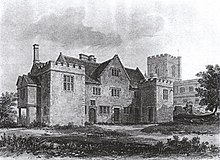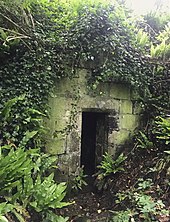Edington Priory

Edington Priory in Wiltshire, England, was founded by William Edington, the bishop of Winchester, in 1351 in his home village of Edington, about 3+3⁄4 miles (6 km) east of the town of Westbury. The priory church was consecrated in 1361 and continues in use as the parish church of Saint Mary, Saint Katharine and All Saints.
History[]
Early history[]
When Edington was recorded in Domesday Book of 1086 it was held by Romsey Abbey.[1] The nuns of Romsey provided a church for their tenants at Edington.[2] Remains of a late-Norman church were found during restoration in the 19th century.[3] North Bradley was a chapelry of Edington at this time.
William Edington[]
William Edington (d. 1366), from an Edington family, became Treasurer of England and bishop of Winchester, and founded a founded a college of chantry priests at Edington in 1351[2] in order to have prayers said for himself, his parents and his brother. The church was transferred from Romsey to the chantry, and William gave further funds and properties in the following years.
Priory[]
In 1358 the chantry became a house of the Bonhommes, an Augustinian community. The establishment was modelled on Ashridge Priory. The chantry's property was transferred to the new foundation and William, with others, added many manors to its wealth until his death in 1366. The first rector, brought from Ashridge, was John de Aylesbury.[4] At the time of his death in 1382 the brethren were eighteen in number.
During Jack Cade's rebellion in 1450, William Ayscough, Bishop of Salisbury and confessor to Henry VI, was forced to flee Salisbury. Seeking refuge in the church at Edington, he was discovered on 29 June, dragged from the high altar during mass and murdered in the fields outside the church.
Paul Bush became provost of the house at Edington. In 1534 at the Dissolution of the Monasteries the house was peacefully dissolved and the brothers given pensions for life. Around 1539, Paul Bush held the prebendal stall of Bishopston in Salisbury Cathedral, where he became one of the residentiary canons.[5] He later became the first bishop of Bristol.
In 1541 most of its estates were obtained by Sir Thomas Seymour.[4]
Monastic remains[]
The site of the monastery, north and northeast of the parish church, is a scheduled ancient monument.[6] Besides the church, five surviving structures are recognised by Historic England; all except the fishpond are Grade I listed.
House called "The Priory"[]
Immediately north of the church, a late medieval house which may incorporate parts of the monastic buildings. Rebuilt 1600, later alterations.[7]
Priory remains[]
North and east of the church, two large rectangular gardens enclosed by walls approximately 3-4 metres high, probably from the monastery, altered early 17th century. One wall has cylindrical piers which may be the remains of a cloister.[8]
Cottage built onto former monastic wall[]
Northeast of the church, on the road which leads to Steeple Ashton. A cottage named The Monastery Garden, possibly 16th century, built into a stretch of wall which may have monastic origins.[9]
Fishpond[]
A large rectangular fishpond, north of the church, which may be monastic in origin. Other adjacent ponds have been filled in.[10]
Ladywell conduit head[]

About 400 metres southwest of the church, a small 14th-century building over the Ladywell spring, with stone water troughs. A conduit carried water to the monastery.[11][12]
Parish church[]

The church stands today, a good example of the transition between the decorated and perpendicular style of church-building. Pevsner writes "A wonderful church and a highly important church. It is so varied in its skyline and so freely embattled that it looks like a fortified mansion ...".[13]
The whole 14th-century church survives, with its interior enhanced in the 17th century, and restoration by C.E. Ponting in 1888–91. It was listed at Grade I in 1968.[14]
The church has medieval glass and contains the burial monuments of several local notables, including tombs removed from St Giles at Imber during the early 1950s, following the evacuation of that village in 1943.[15]
In 2014 a new organ by Harrison & Harrison was installed.[16]
Every August since 1956 a festival of church music, the Edington Festival of Music within the Liturgy, is held here.[17][18]
See also[]
Gallery[]

The Priory House in 2008

Pews in the nave

Roof of the nave
References[]
- ^ Edington in the Domesday Book
- ^ a b Church History, Friends of Edington Priory Church
- ^ "Victoria County History - Wiltshire - Vol 8 pp239-250 - Edington". British History Online. University of London. Retrieved 23 November 2015.
- ^ a b "Victoria County History - Wiltshire - Vol 3 pp320-324 - House of Bonhommes: Edington". British History Online. University of London. Retrieved 23 November 2015.
- ^
 This article incorporates text from a publication now in the public domain: Venables, Edmund (1886). "Bush, Paul". In Stephen, Leslie (ed.). Dictionary of National Biography. Vol. 8. London: Smith, Elder & Co.
This article incorporates text from a publication now in the public domain: Venables, Edmund (1886). "Bush, Paul". In Stephen, Leslie (ed.). Dictionary of National Biography. Vol. 8. London: Smith, Elder & Co.
- ^ Historic England. "Edington Priory (site of) (1004709)". National Heritage List for England. Retrieved 23 November 2015.
- ^ Historic England. "The Priory (1285064)". National Heritage List for England. Retrieved 23 November 2015.
- ^ Historic England. "Remains of Abbey or Priory in grounds of The Monastery Garden (1021493)". National Heritage List for England. Retrieved 23 November 2015.
- ^ Historic England. "The Monastery Garden (1021492)". National Heritage List for England. Retrieved 23 November 2015.
- ^ Historic England. "Fishponds of Edington Priory (891282)". Research records (formerly PastScape). Retrieved 23 November 2015.
- ^ Historic England. "Conduit head (spring) (1181417)". National Heritage List for England. Retrieved 23 November 2015.
- ^ Historic England. "Scheduled Monument: Monk's Conduit well house (1017297)". National Heritage List for England. Retrieved 23 November 2015.
- ^ Pevsner, Nikolaus; Cherry, Bridget (revision) (1975) [1963]. Wiltshire. The Buildings of England (2nd ed.). Harmondsworth: Penguin Books. p. 234. ISBN 0-14-0710-26-4.
- ^ Historic England. "Church of St Mary, St Katherine and All Saints (1364257)". National Heritage List for England. Retrieved 23 November 2015.
- ^ "Priory Church of St. Mary, St. Katherine and All Saints, Edington". Wiltshire Community History. Wiltshire Council. Retrieved 23 November 2015.
{{cite web}}: CS1 maint: url-status (link) - ^ "Edington villagers help pack up organ bound for school in Estonia". This is Wiltshire. 4 February 2014. Retrieved 23 November 2015.
- ^ "The Edington Festival of Music within the Liturgy". Retrieved 23 November 2015.
- ^ "Edington heads for the limelight". BBC - Wiltshire. 29 October 2014. Retrieved 23 November 2015.
External links[]
| Wikimedia Commons has media related to Edington Priory. |
- Images from the BBC
- Bayntun Tomb mystery at bayntun-history.com, archived in August 2019
- Augustinian monasteries in England
- Monasteries in Wiltshire
- Grade I listed monasteries
- Grade I listed churches in Wiltshire
- 1332 establishments in England
- Christian monasteries established in the 14th century



